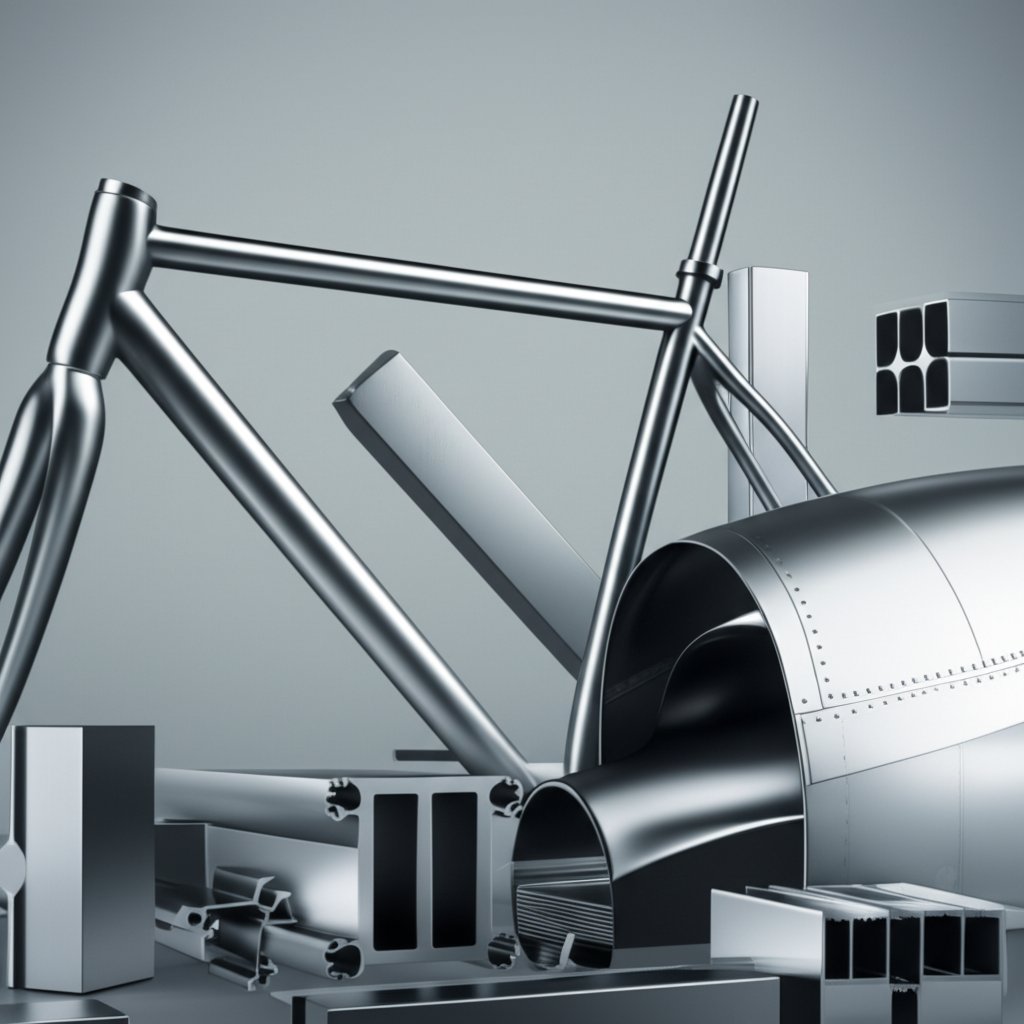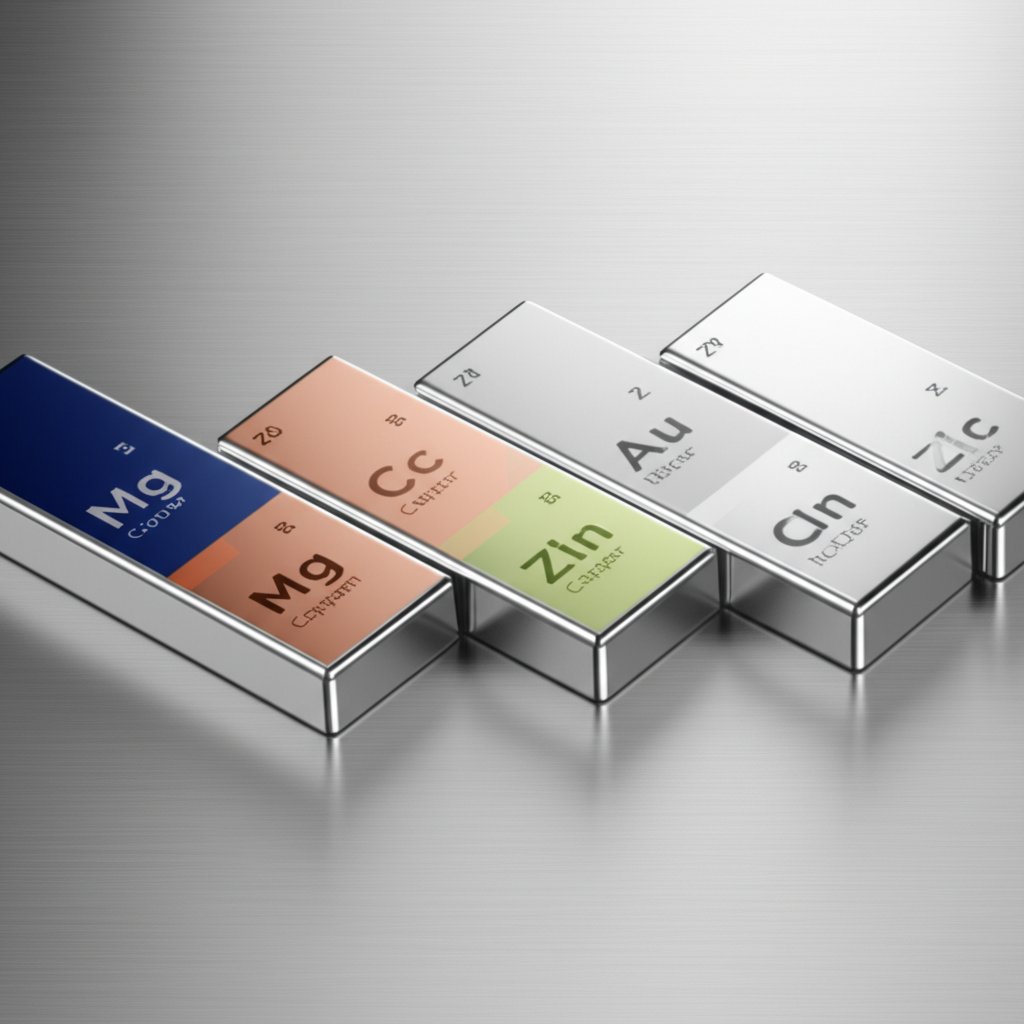
When you pick up an aluminum can or notice how lightweight a bicycle frame feels, you’re experiencing one of aluminum’s most defining traits: its density. But what exactly does "density" mean, and why is it so important for aluminum?
In scientific terms, density is the amount of mass packed into a given volume. The formula is straightforward:
For aluminum, this value is remarkably low compared to other common metals. In standard units, the density of aluminum is typically expressed as:
The standard density of aluminum is approximately 2.7 g/cm³ (or 2,700 kg/m³).
This means that aluminum is about one-third as dense as steel or copper, making it one of the lightest metals used in modern engineering and manufacturing.
Why does this matter? A lower density translates directly into lighter products and structures—without sacrificing strength. That’s why aluminum is a top choice for applications where weight savings are crucial, such as in aerospace, automotive, and portable electronics. If you’ve ever wondered, "how dense is aluminum compared to other metals?" or "what is the density of aluminum in g/cm³?"—now you have your answer.
To sum up, the density of aluminum is a fundamental property that not only sets it apart from other metals but also drives its widespread use in industries where every ounce counts. Whether you’re an engineer calculating material weight or just curious about why aluminum feels so light, understanding its density is key to unlocking its full potential.

Ever wondered why aluminum feels so much lighter than steel or copper? The answer lies not just in its famous low density, but in the very heart of its atomic structure. Let’s break down exactly what makes aluminum stand out on the aluminum periodic table—and why these atomic details matter for engineers and designers.
First, aluminum sits in Group 13 of the periodic table and has an atomic number of 13. This number tells us it has 13 protons in its nucleus—and, in a neutral atom, 13 electrons buzzing around it. The aluminum atomic number also reveals its position among the lighter metals, far below denser elements like iron (Fe, atomic number 26) or lead (Pb, atomic number 82).
Aluminum’s electron configuration is 1s2 2s2 2p6 3s2 3p1, or more simply, [Ne] 3s23p1. This means it has three valence electrons—a detail that not only determines its chemical reactivity but also its ability to form strong yet lightweight metallic bonds (source).
So, how does this atomic design compare to denser metals? Take iron, for example: it has a higher atomic number, a much greater atomic mass, and a body-centered cubic (BCC) structure that packs atoms more tightly. The result? Iron’s density is almost three times higher than that of aluminum.
In short, aluminum’s low atomic mass, moderate atomic radius, and efficient—but not overly packed—FCC crystal structure all combine to give it a uniquely low density. Next, we’ll see how this lightweight nature stacks up against other metals in a detailed comparison table.
Imagine you’re deciding which material to use for a new car part, a structural beam, or even a smartphone case. One of the first questions to ask is: how much does it weigh? The answer comes down to density. While we know the density of aluminum is low, how does it actually compare to other workhorse metals like steel, copper, titanium, or magnesium?
Let’s break it down with a direct, side-by-side comparison. Below you’ll find a detailed table showing the densities of these common metals in three units—grams per cubic centimeter (g/cm³), kilograms per cubic meter (kg/m³), and pounds per cubic inch (lb/in³). You’ll quickly see why aluminum is often the top pick when weight matters most.
| Metal | Density (g/cm³) | Density (kg/m³) | Density (lb/in³) |
|---|---|---|---|
| Aluminum | 2.70 | 2,700 | 0.0975 |
| Steel | 7.85 | 7,850 | 0.284 |
| Stainless Steel | 7.80 | 7,800 | 0.282 |
| Copper | 8.96 | 8,960 | 0.324 |
| Titanium | 4.51 | 4,510 | 0.163 |
| Magnesium | 1.74 | 1,740 | 0.063 |
| Iron | 7.87 | 7,870 | 0.284 |
| Lead | 11.3 | 11,300 | 0.409 |
| Gold | 19.3 | 19,300 | 0.698 |
Looking at the table, you’ll notice aluminum’s density is roughly one-third that of steel, iron, or copper. For example, steel density is about 7.85 g/cm³, while aluminum comes in at just 2.70 g/cm³. This dramatic difference means that if you swapped a steel part for an aluminum one of the same size, you’d cut the weight by nearly 65%—without necessarily sacrificing strength or durability in many applications.
Stainless steel density is nearly identical to regular steel, so the weight advantage of aluminum remains just as clear. Copper, another common industrial metal, is even denser than steel. On the other end of the spectrum, magnesium is even lighter than aluminum, but it’s often not as strong or corrosion-resistant.
What about denser metals like lead or gold? These are used where weight is an advantage (think radiation shielding or jewelry), but for most engineering and manufacturing needs, their high density is a drawback.
In summary, when you ask, “how does the density of aluminum compare to steel density or the density of iron?”—the answer is clear: aluminum’s low density is a game-changer for any application where reducing weight is a top priority. Next, we’ll see how tweaking aluminum’s composition with alloying elements can further fine-tune its density and performance.

When you look at a piece of aluminum in your hand, you might not realize that its density can be fine-tuned for different jobs. How? By adding other elements to create what are known as aluminum alloys. This process doesn’t just tweak the color or strength—it directly influences the material’s density, and therefore, its weight and performance in real-world applications.
Sounds complex? Let’s break it down. Pure aluminum has a density of about 2.70 g/cm³. But when manufacturers introduce alloying elements—such as magnesium, silicon, copper, or zinc—the density shifts. The result is a wide range of common alloys tailored for everything from aircraft frames to beverage cans. But why does this happen?
Each element added to aluminum brings its own atomic mass and volume. Here’s what that means in practice:
Imagine mixing sand (heavy) or feathers (light) into a bucket of water—the overall weight changes based on what you add. The same principle applies at the atomic level for metal alloys.
For example, the 5xxx series of aluminum alloys, which use magnesium as the primary alloying element, are especially prized in marine and automotive industries for their lightweight and corrosion-resistant properties. On the other hand, the 2xxx and 7xxx series, containing copper and zinc respectively, offer higher strength but also a slightly higher density—making them a go-to choice for high-stress applications like aerospace components.
Let’s put this into perspective with a few numbers. Pure aluminum clocks in at 2.70 g/cm³. But:
Even a small shift in composition can have a measurable effect on weight, especially when you’re designing large structures or components. That’s why understanding the density of aluminum alloys is so important for engineers and designers.
It’s not just aluminum alloys that change density with additives. Consider the density of brass (a copper-zinc alloy) or the density of bronze (a copper-tin alloy)—both are much heavier than even the densest aluminum alloys, often ranging from 8.4 to 8.9 g/cm³ (Engineering Toolbox). This is why aluminum alloys are preferred where weight savings are critical, while brass and bronze are chosen for their strength and wear resistance in different applications.
Alloying doesn’t just affect density. It also impacts other key properties, such as the heat capacity of aluminum (how much energy it takes to heat it up), corrosion resistance, and even the charge of aluminum ions in chemical reactions. This means that by carefully selecting alloying elements, manufacturers can create materials with the exact balance of weight, strength, and durability needed for any task. To explore how alloying elements impact aluminum’s density for your specific application—from aerospace to consumer electronics—dive into our detailed guide Understanding Aluminum Density: A Comprehensive Analysis.
In summary, the art of alloying allows aluminum to be customized for a huge range of uses. Whether you’re building a lightweight bicycle, a sturdy aircraft wing, or a corrosion-resistant marine panel, understanding how alloying elements modify density—and other properties—gives you the power to choose the perfect material for your needs. Next, we’ll look at a detailed chart of specific aluminum alloys and their densities, so you can make informed decisions for your next project.
Imagine you’re tasked with designing a lightweight structure—an aircraft wing, a bicycle frame, or a vehicle chassis. You know the density of pure aluminum, but what happens when you use an alloy like 6061 or 7075? The answer can make or break your calculations. That’s why having a reliable, up-to-date metal density chart is essential for engineers and designers who need precision at every step.
To save you time, we’ve compiled a comprehensive metal density table of the most common aluminum alloys, using authoritative data from industry standards and technical resources. This chart allows you to quickly reference the density of 6061 aluminum, 7075, and other widely used grades—making your weight calculations both fast and accurate.
You might wonder: does a small change in alloy composition really affect weight? Absolutely. For example, the density of aluminum alloy 6061 is nearly identical to pure aluminum, but the 7075 density is noticeably higher due to added zinc and copper. When you’re scaling up to large components or assemblies, even a 0.1 g/cm³ difference can mean significant weight savings—or overruns.
| Alloy Series | Grade | Density (g/cm³) | Density (lb/in³) |
|---|---|---|---|
| 1000 (Commercially Pure) | 1100 | 2.71 | 0.098 |
| 3000 (Mn Alloyed) | 3003 | 2.73 | 0.099 |
| 5000 (Mg Alloyed) | 5052 | 2.68 | 0.097 |
| 6000 (Mg & Si Alloyed) | 6061 | 2.70 | 0.098 |
| 6000 (Mg & Si Alloyed) | 6061-T6 | 2.70 | 0.098 |
| 7000 (Zn Alloyed) | 7075 | 2.81 | 0.102 |
Let’s look closer at two of the most requested grades. The density of 6061 aluminum is 2.70 g/cm³ (0.098 lb/in³), whether you’re using the standard or the popular heat-treated density of al 6061 t6 variant. In contrast, al 7075 density rises to 2.81 g/cm³ (0.102 lb/in³), reflecting its higher zinc and copper content. This difference is crucial in aerospace and high-performance engineering—where every gram counts.
So, if you’re optimizing for weight, the density of aluminum alloy 6061 is a clear winner for lightweight structures. But if you need maximum strength, and a little extra weight is acceptable, 7075 is often the go-to choice.
Here’s a quick scenario: You’re calculating the mass of a custom extrusion or a machined part. Simply multiply the part’s volume by the correct alloy density from the table above. For example, a 1,000 cm³ block of 7075 aluminum will weigh 2,810 grams, while the same block of 6061 will weigh 2,700 grams—a difference of 110 grams, which can be critical in aerospace or automotive applications.
For even more alloys, or to compare with other metals, consult a full metal density chart or metal density table—vital tools for any engineer or designer working with aluminum.
Now that you can pinpoint the exact density for your chosen alloy, you’re ready to calculate part weights with confidence. Next, let’s explore how temperature and processing can further influence the density of aluminum in real-world manufacturing.

When you’re designing with aluminum, you might assume its density is a fixed number. But did you know that factors like temperature and manufacturing method can subtly—but importantly—alter the density of aluminum? Let’s break down why this matters, especially when precision is key in engineering and manufacturing.
Imagine you’re working with aluminum in a high-temperature environment, such as a foundry or a heat exchanger. As the temperature rises, the atoms in the metal vibrate more vigorously and move farther apart. This causes the material to expand, which means its volume increases while its mass remains the same. The result? A slight decrease in density.
The coefficient of linear thermal expansion for aluminum is approximately 0.000023 per °C
So, if you heat a block of aluminum from room temperature up toward its aluminum melting point (about 660°C), its density will drop slightly. This effect is especially important in applications where parts are exposed to high temperatures, such as engines, aerospace components, or industrial ovens. Even though the change is small, it can impact performance and design tolerances.
But temperature isn’t the only factor. The way aluminum is processed—whether it’s cast or wrought—also influences its final density. Here’s how it works:
For example, the specific gravity of aluminium (the ratio of its density to that of water) typically ranges from about 2.55 to 2.80, with cast forms often at the lower end and wrought at the higher end. This means that if you’re selecting between cast and wrought products—say, for a structural frame or a precision-machined part—you’ll want to account for this subtle but real difference.
In summary, while the density of aluminum is a reliable baseline, real-world factors like temperature and processing technique can nudge it up or down. Understanding these variables helps you make smarter choices—whether you’re engineering a lightweight aircraft component or a durable industrial part. Next, we’ll show you how to use these density values to calculate the weight of your aluminum parts with confidence.
Ever wondered how engineers know exactly how much an aluminum part will weigh—even before it’s made? The secret lies in a simple formula that uses the density of aluminum. Whether you’re sizing up a sheet for a project or estimating shipping costs, knowing how to do this calculation is a game-changer.
Let’s break it down with an easy, real-world example using a 1-meter square aluminum sheet. We’ll cover both metric and imperial units, so you can use whichever system fits your needs.
So, the formula looks like this:
If you prefer imperial units, here’s how you’d do it for the same sheet, but in inches:
Volume = 39.37 × 39.37 × 0.197 ≈ 3,060 cubic inches
Weight = Volume × aluminum density lb/in3
Weight = 3,060 in³ × 0.0975 lb/in³ = 298.35 lb
This method works for any shape—just calculate the volume, then multiply by the density of aluminum in lb/in3 or kg/m3, depending on your preferred units. It’s also how you’d figure out the weight of aluminum per cubic inch for more complex parts.
Getting the density right isn’t just a math exercise. If you use the wrong value—say, confusing steel density kg/m3 (7,850 kg/m³) with aluminum’s much lower 2,700 kg/m³—you could end up with a part that’s far heavier or lighter than intended. Always double-check your material’s density, especially for critical engineering or manufacturing applications (reference).
Now that you know how to calculate the weight of any aluminum part, you’re equipped to estimate costs, plan logistics, and make smarter design choices. In the final section, we’ll discuss why sourcing aluminum with guaranteed properties is essential for high-performance projects.
When you’re building the next generation of aircraft, electric vehicles, or cutting-edge architecture, every detail matters—including the precise density of your aluminum materials. Imagine designing a lightweight aerospace component or an energy-efficient building facade, only to discover that the aluminum plate or aluminum sheets you sourced don’t quite match the density you specified. Even a small deviation can throw off weight calculations, impact structural integrity, and compromise safety or performance.
Why is this so critical? In high-performance industries like aerospace, automotive, and construction, the density of aluminum must be consistent and reliable. Unlike some common metals—where a slight density variation may not impact the end use—aluminum’s low density is often the very reason it’s chosen. Whether you’re working with us aluminum standards or international specifications, ensuring that your material matches the required density is essential for meeting design weights and structural requirements (reference).
That’s why sourcing from a trusted, specialized manufacturer is so important. Shengxin aluminium stands out as a professional aluminum profile manufacturer in China, offering certified products that consistently meet rigorous density and quality standards. Their expertise ensures that whether you’re ordering custom extrusions, large-format plates, or precision-milled sheets, every batch aligns with the exacting requirements of your project.
In a market crowded with common metals suppliers, choosing a partner with a proven track record of quality and technical support can make all the difference. Shengxin’s advanced production lines and comprehensive quality control guarantee not only the right density but also the performance and reliability your application demands.
So, as you plan your next project—be it in aerospace, automotive, or construction—remember: achieving the specified density of aluminum isn’t just a technicality. It’s the foundation of safety, efficiency, and innovation. By partnering with a reputable supplier like Shengxin aluminium, you gain the confidence that your designs will perform exactly as intended, every time.
Aluminum has a density of about 2.7 g/cm³, which equals 2,700 kg/m³ or 0.0975 lb/in³. This low density makes aluminum a preferred material for lightweight engineering applications.
Aluminum's density is roughly one-third that of steel or copper, making it significantly lighter. This property allows for substantial weight savings in industries like aerospace and automotive, where reducing mass is crucial.
Yes, adding elements such as magnesium or silicon can lower aluminum's density, while copper or zinc can increase it. The resulting alloys are tailored for specific properties and applications, balancing weight and strength.
To find the weight, multiply the part's volume by the density of the specific aluminum alloy. Accurate density values are essential for precise calculations, especially in technical fields.
Consistent density ensures that aluminum components meet design specifications, structural integrity, and safety standards. Reliable suppliers like Shengxin aluminum provide certified materials with verified density, supporting high-performance projects.
 Onlineservice
Onlineservice 0086 136 3563 2360
0086 136 3563 2360 sales@sxalu.com
sales@sxalu.com +86 136 3563 2360
+86 136 3563 2360